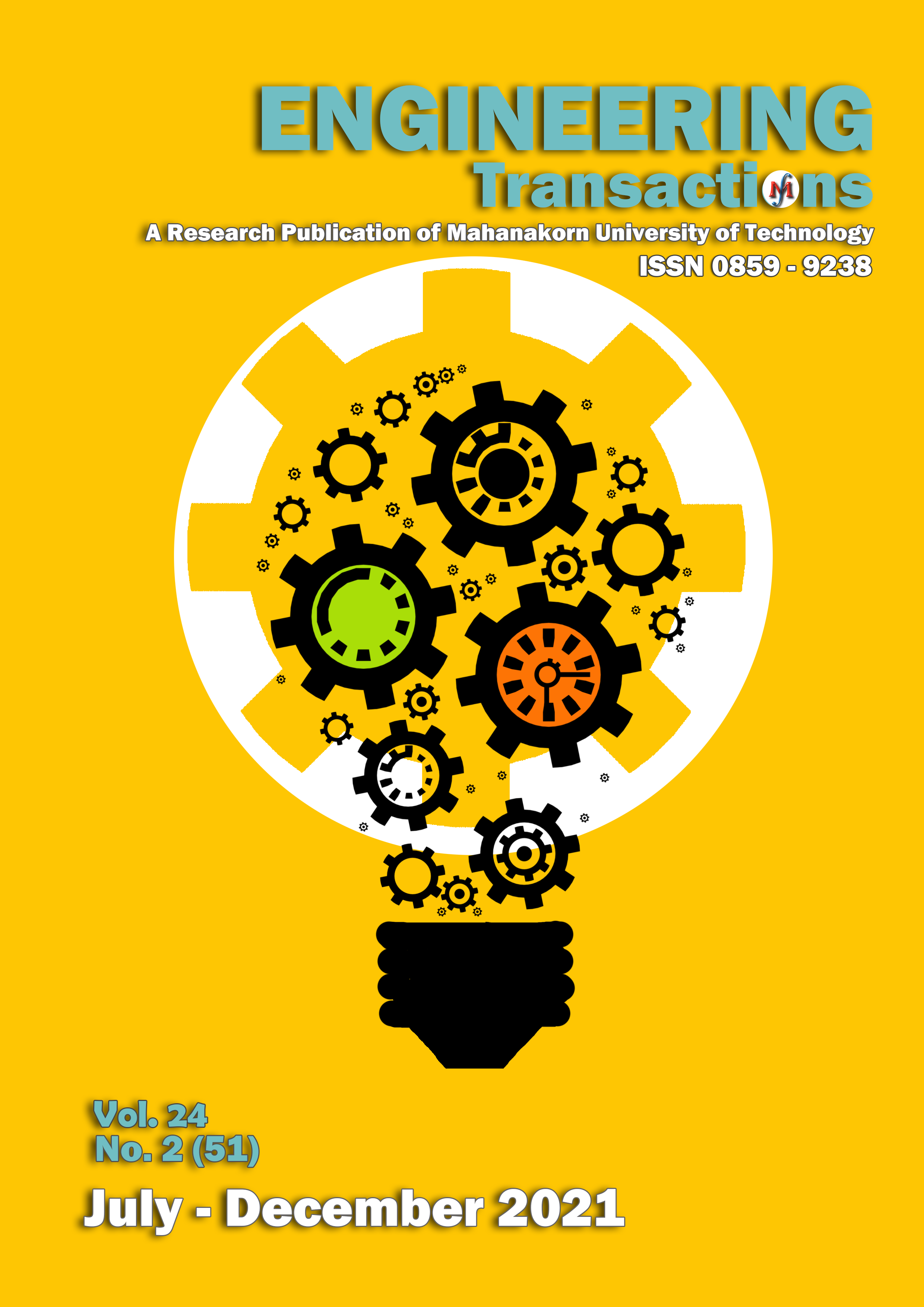Effect of Air-Flow on Bio-drying process in Municipal Solid Waste for Biomass Storage
Main Article Content
Abstract
This paper proposes an effect of air-flow on bio-drying process of municipal solid waste (MSW). Properties of MSW are considered as the moisture content and optimal air-flow for bio-drying process. The organic MSW is an alternative way to recycle and transform the organic solid waste into energy. The objective is to determine the bio-drying properties in forms of air-flow rate for the organic MSW in order to decrease the humidity and to determine the optimal air flow rate for bio-drying that can be brought to reduce the humidity before storing in the warehouse. This paper presents an air-flow model of organic MSW for bio-drying that is suitable for the amount of organic solid waste decreased the humidity of the organic waste. Organic MSW is the household food waste for turning the food waste to energy in forms of biomass. 200-Litre Plastic barrel drum is used for experimental model with the different weight of MSW mass between 5 to 50 kg in the closed system. Experiments are performed at the air-flow volume and the different weight of organic solid waste. Empirical results show that the air-flow rate is proportional to the air inlet volume, which if the mass of organic solid waste increases, temperature and humidity will increase. It found that 30 kg of organic solid waste mass and 60% volume of plastic barrel drum with the air-flow rate of 24.39 m3/kg/hr or 430.67 CFM per 30 kg of MSW mass can achieve the lowest humidity at 11.8%.
Article Details
Copyright @2021 Engineering Transactions
Faculty of Engineering and Technology
Mahanakorn University of Technology
References
[2] D. Chen, L. Yin, H. Wang and P. He. “Pyrolysis technologies for municipal solid waste: A review”, Waste Management, 34, pp. 2466-2486, 2014.
[3] J. Faitli, T. Magyara, A. Erdélyib and A. Murányic, “Characterization of thermal properties of municipal solid waste landfills”, Waste Management, 36, pp. 213-221, 2015.
[4] S. Sitjongsataporn, P. Srisuk, “Municipal Solid Waste and Dielectric Heating”, Engineering Transactions, vol. 19, no. 1, pp. 55-58, Jan.-Jun., 2016.
[5] H. Liu, X. Maa, L. Li, Z. Hua, P. Guo, Y. Jiang, “The catalytic pyrolysis of food waste by microwave heating”,Bioresource Technology, 166, pp. 45–50, 2014.
[6] D. Beneroso, J. M. Bermúdez, A. Arenillas, J. A. Menéndez, “Integrated microwave drying, pyrolysis and gasification for valorization of organic wastes to syngas”, Fuel, 132, pp. 20–26, 2014.
[7] H. Zhou, A. Hong, M. Yan, Q. Longa, Q. Hai, L. Yan, G. Zhang, “An overview of characteristics of municipal solid waste fuel in China: Physical, chemical composition and heating value”, Renewable and Sustainable Energy Reviews, 36, pp. 107–122, 2014.
[8] F. J. Colomer, M. Antonio, G. Izquierdo, M. D. Bovea, F. R. Martínez, M. Lidón, H. Prats, “Biodrying as a biological process to diminish moisture in gardening and harvest wastes”, Environment, Development and Sustainability, 2012.
[9] A. P. Toma, R. Pawels, A. Haridas, “Biodrying process: A sustainable technology for treatment of municipal solid waste with high moisture content”, Waste management, 2016.
[10] D. Zhang, Z. Xu, G. Wanga, N. Huda, G. Li, W. Luo, “Insights into characteristics of organic matter during co-biodrying of sewage sludge and kitchen waste under different aeration intensities”, Environmental Technology & Innovation, vol. 20, 2020.
[11] B. Zaman, M. A. Budihardjo, S. M. Yasmine and M. Purwono, “Performance of Biodrying Process based on Temperature Profile and Cumulation”, Journal of Physics: Conference Series: International Conference on Sustainable Infrastructure, vol. 1625, 2020.
[12] K. Ngamket, K. Wangyao and S. Towprayoon, “Comparative Biodrying Performance of Municipal Solid Waste in the Reactor under Greenhouse and Non-greenhouse Conditions”, Journal of Environmental Treatment Techniques, vol. 9, Issue 1, pp. 211-217, 2021.
[13] F. Feltrim, R.L.S. Izzo, J. L. Rose, A. B. Machado and S. R. Oro, “Evaluation of the bio-drying process of municipal solid waste using rotating drums Bio-drying rotary drum”, Annals of the Brazilian Academy of Sciences, vol. 93(4), 2021.
[14] R. Teerawattana, U. Uyasatian and W. Nutmagul, “Physical Composition Based Model for Higher Heating Value Prediction of Refuse-derived Fuel”, KKU Science Journal, vol. 40 (2), pp. 612-621, 2012.
[15] Pollution Control Department, “Thailand State of Pollution Report 2008”, Kotchakorn Publishing, Bangkok, pp. 18-20, 2008 (in Thai).
[16] V. Vidyadhar and I. Regupathi, “Pyrolysis of municipal solid waste for syngas production by microwave irradiation”, Natural Resources Research, vol.21, no. 1, pp. 75-82, Mar. 2012.
[17] I. Boumanchar, Y. Chhiti, F. Ezzahrae, M. Alaoui, A. Sahibed-dine, F. Bentiss, C. Jama and M. Bensitel, “Municipal solid waste higher heating value prediction from ultimate analysis using multiple regression and genetic programming techniques”, Waste Management & Research, vol. 37(6), pp. 578–589, 2019.
[18] B. Zaman1, B. P. Samadikun, N. Hardyanti, P. Purwono, “Waste to Energy: Calorific Improvement of Municipal Solid Waste through Biodrying”, Environmental and Climate Technologies, vol. 25, no. 1, pp. 176–187, 2021.


